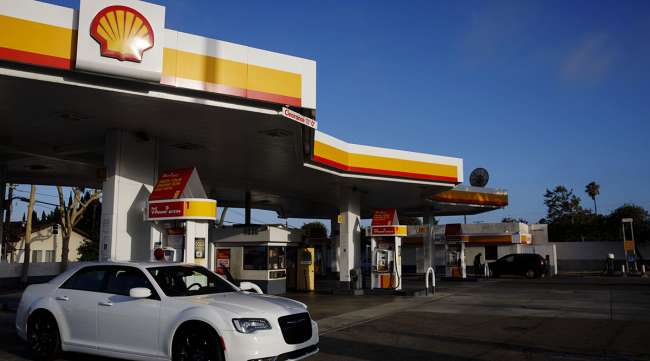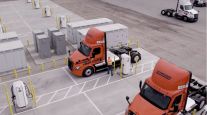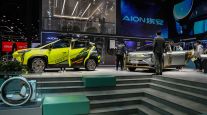Staff Writer
Trucking Must Contemplate Alternative Energy, Shell Officials Say

[Stay on top of transportation news: Get TTNews in your inbox.]
COLLEGE STATION, Texas — By 2050, Earth’s population will have eclipsed 9 billion, according to the most widely accepted projections. That’s 2 billion more than are alive today — 2 billion more consuming food, power and making use of increasingly complex technologies.
At a Shell Rotella fleet symposium Nov. 13, speakers said that means the pressure is on for trucking executives.
“If you really look at the rate of change … it is just happening faster and faster and faster,” said Dan Arcy, Shell Rotella’s global OEM technical manager and industry trade association liaison. “So we really need to start looking at these things now to determine what we’re going to do.”
RELATED: Shell Unveils Natural Gas Engine Oil

Guerrero
Energy required in the transportation sector could increase by 70% if no drastic changes or improvements are made, Chris Guerrero, global transport marketing director for Shell Lubricants, said in the opening remarks. And though energy intensity is projected to fall due to efficiency advances, CO2 emissions still are expected to increase by around 33%. Commercial road-freight transport companies bear responsibility for limiting those emissions, Guerrero said.
For example, if all on-highway trucks in the U.S. market achieved a 1% fuel economy improvement, about 8.23 billion pounds of CO2 would be reduced every year globally. That would be the same as removing an estimated 23,000 trucks from the road.
“We’re going to have a mosaic of solutions to help meet the rising energy needs of this world,” said Megan Pino, Shell Rotella’s global brand manager. “We see a lot of studies and articles and coverage on the future of mobility when it comes to passenger cars, and so we want to elevate and bring forth a similar viewpoint from a freight transport perspective.”
In light of the challenges ahead, Shell has worked to rebrand itself as a sustainable energy company, shifting away from the oil and gas company reputation it’s built over the past century. And it’s doing that in part through collaborations with organizations such as the North American Council for Freight Efficiency (NACFE), which advocates efficient and environmentally minded technologies in the freight industry, and management consulting firm Kline Group.
In addition to NACFE and Kline, Shell worked with Texas A&M Transportation Institute (TTI) to host the event. TTI, founded in 1950 to respond to Texas DOT needs, operates as a state agency and a member of the Texas A&M University System.

Rutter
In some areas, TTI’s research questions align with Shell’s own for the future. TTI serves public and private sector interests, which puts the institute in a unique spot between them. Allan Rutter, TTI’s division head of freight and investment analysis, spoke on how the two should be in frequent communication as new technologies enter the transportation industry in the coming decades.
He posed a simple question: How do multiple entities create an environment for change to flourish?
Adoption of new technologies will be sped up or slowed by governmental regulations, and by sturdy proof that technologies can add real value. Companies, he said, will continue to be wary of technological advances winding up as fads rather than game-changers.
David Tsui, a project manager in energy at the Kline Group, said that while consumers and executives alike may want a greener, better Earth, few are willing to pay more for it.
“Why would a company invest in an energy-efficient truck?” Tsui said. “Where’s the cost benefit? Well, those vehicles tend to have lower costs on maintenance and fuel, so total cost of ownership is reduced over the long term, even if the initial price is 50% higher than a normal Class 8, as Tesla’s electric truck, for example, likely will be. When that total cost ownership goes down even further, adoption rate will increase.”

Roeth
Many, including NACFE Executive Director Mike Roeth, believe that electric trucks will become the primary nondiesel fuel consideration for fleets, with hydrogen emerging as another possibility if range and fill times for electric trucks aren’t able to match diesel. Though he noted considerable hurdles to a wider adoption of electric trucks — namely the construction of charging ports and a more robust electrical grid — he believes that fleets will soon find use for electrics in Classes 3-6 routes, where electric technology will reach parity with diesel at an earlier date, according to NACFE. The day-cab duty cycle is the biggest early opportunity for electric trucks, he said.
For Classes 7-8 vehicles, however, electric technology will not reach parity with diesel in categories such as “initial cost” and “max life before obsolete,” until after 2030. That means that as long as fuel prices remain reasonable, diesel will continue to be a fixture for at least the near future.
Nonetheless, Roeth said that NACFE’s research shows the electric truck as the writing on the wall.
“What surprised me were all the benefits of an electric truck compared to a diesel truck, which makes it hard to judge for cost of ownership,” he said. “And we’ve heard that it’s a lot easier to hire an electrical mechanic than it is to hire a diesel mechanic.”
Want more news? Listen to today's daily briefing:




